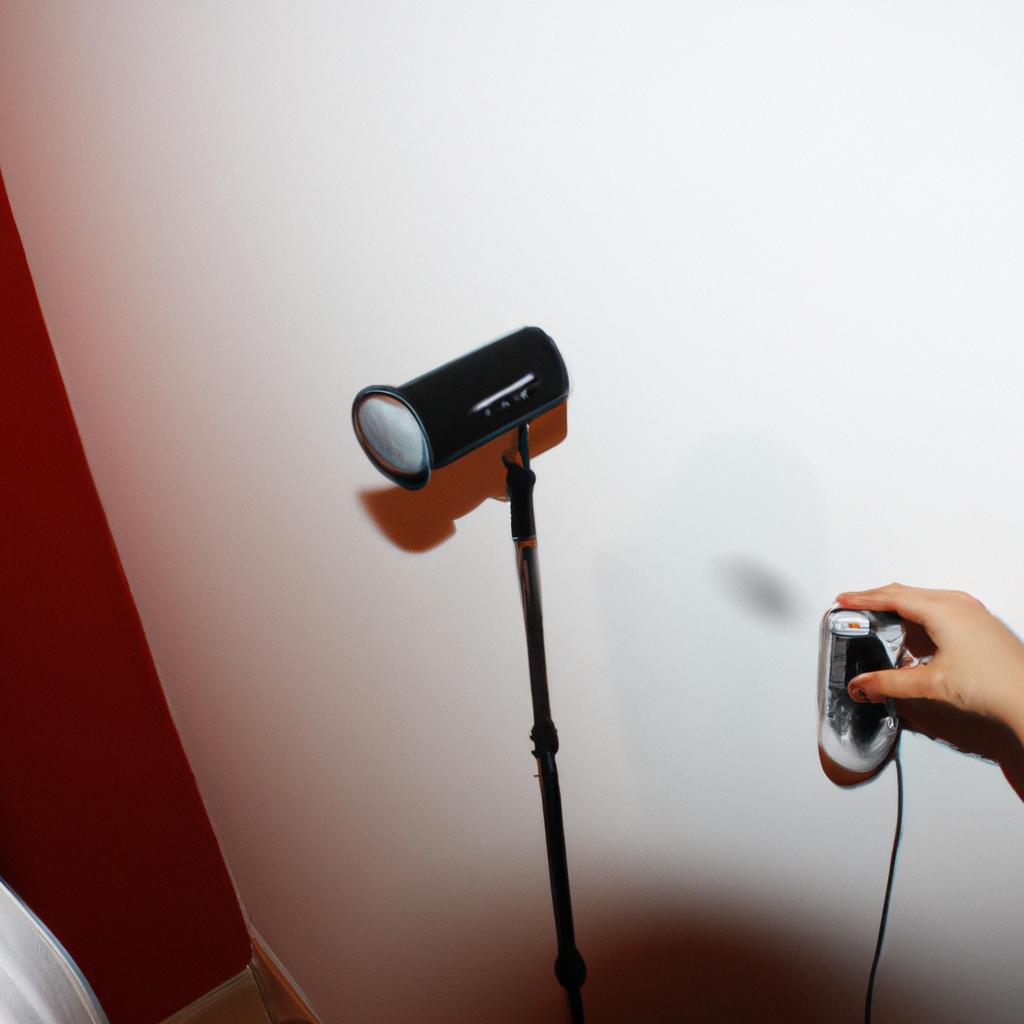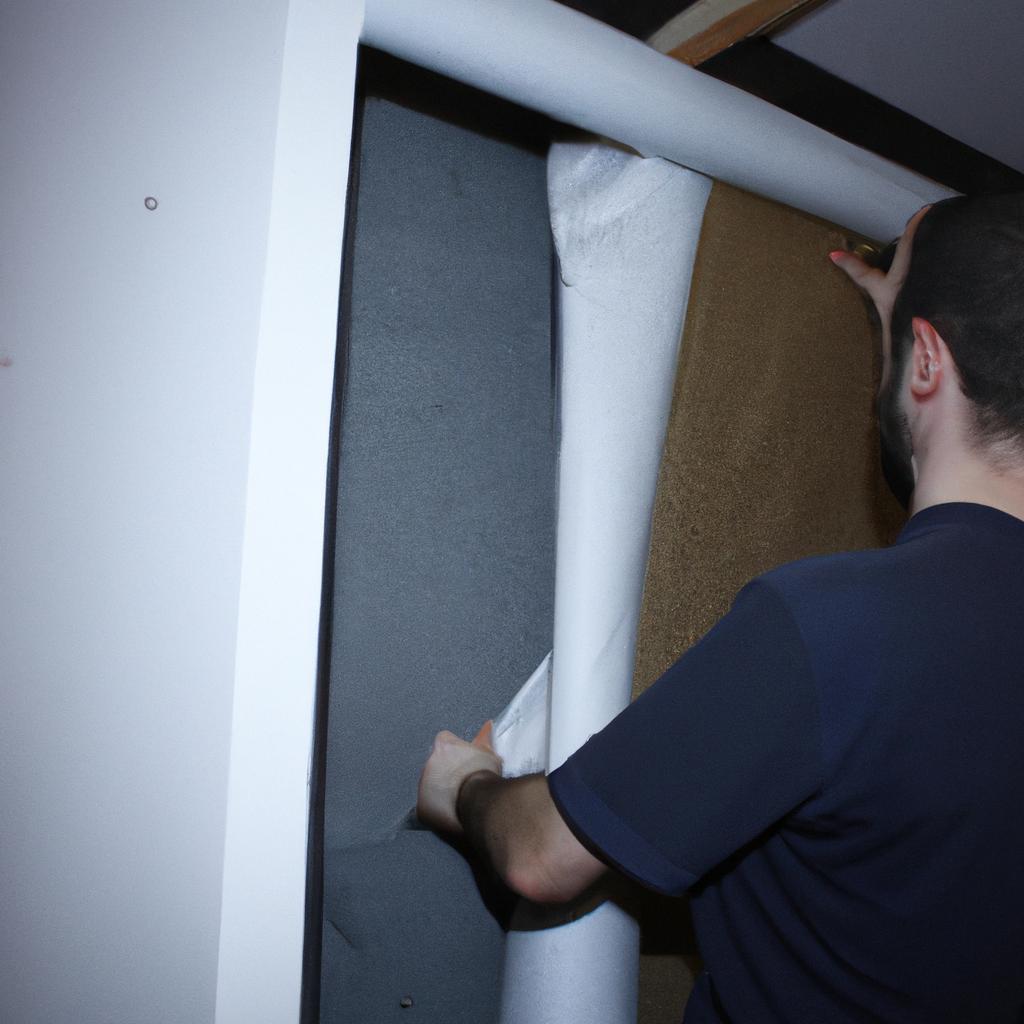In the realm of sound and vision, acoustics play a crucial role in shaping our auditory experiences. From concert halls to home theaters, understanding the principles behind acoustics is essential for creating immersive audio environments. For instance, consider a hypothetical scenario where an aspiring filmmaker desires to create a captivating movie experience through the integration of high-quality sound effects with stunning visuals. In order to achieve this goal, it becomes imperative for them to comprehend the intricacies of acoustics and how it influences the perception and reception of sound.
Acoustics, as a branch of physics, studies the properties and behavior of sound waves in various mediums such as air, water, or solid objects. By examining phenomena like reflection, refraction, absorption, and diffraction, acousticians strive to explain how sound interacts with its environment. Understanding these fundamental concepts allows engineers and designers to optimize acoustic conditions in different settings according to specific requirements. For example, architects apply their knowledge of acoustics when designing spaces like concert halls or recording studios to ensure optimal sound dispersion and minimal interference from unwanted reflections or echoes. Similarly, multimedia developers employ acoustical considerations while integrating audio elements into virtual reality (VR) experiences or video games to enhance immersion and realism.
This article aims to provide a comprehensive overview of the key principles and applications of acoustics in the context of creating captivating audio-visual experiences. By delving into topics such as sound propagation, reverberation, sound absorption, and spatial audio techniques, readers will gain a deeper understanding of how these concepts can be utilized to enhance the impact and quality of sound in various settings. Furthermore, we will explore the role of acoustics in cinema and theater design, highlighting the importance of proper acoustic treatment for achieving optimal sound reproduction and audience engagement. Additionally, we will discuss advancements in technology that have revolutionized the field of acoustics, such as immersive audio formats like Dolby Atmos and Ambisonics, which offer new dimensions to storytelling through their ability to create three-dimensional soundscapes. Whether you are a filmmaker, architect, or simply someone interested in the science behind our auditory experiences, this article aims to equip you with valuable insights into the world of acoustics and its profound impact on our perception of sound and vision.
Understanding Room Sound
The impact of room acoustics on sound quality cannot be underestimated. Imagine attending a live concert in two different venues: one is an intimate theater with plush seating and velvet curtains, while the other is an open-air stadium filled with roaring fans. Despite the same performers and equipment, the experience can vary greatly due to differences in room sound. In this section, we will explore various aspects of understanding room sound and its effect on our auditory perception.
To begin, let us delve into the factors that contribute to room sound. The size and shape of a space play crucial roles in determining how sounds behave within it. A smaller room tends to have more reflections, creating a sense of intimacy but potentially leading to muddiness or echoey effects. On the other hand, larger spaces may result in longer reverberation times, allowing sounds to linger for extended periods and fostering a grandiose atmosphere. Additionally, materials used in construction directly influence the absorption or reflection of sound waves; hard surfaces like concrete amplify echoes, whereas soft furnishings such as carpets absorb them.
Understanding these principles helps us optimize room acoustics for specific purposes. Whether it’s designing a concert hall that envelops listeners with rich harmonies or constructing a conference room where clear communication prevails, careful consideration must be given to achieve desired acoustic properties. To emphasize this point further:
- Reverberation time affects speech intelligibility.
- Echoes can interfere with music appreciation.
- Excessive background noise hinders effective communication.
- Uncontrolled bass frequencies distort audio reproduction.
To illustrate the practical implications of these concepts, consider Table 1 below:
Table 1: Impact of Room Acoustic Elements
| Element | Effect |
|---|---|
| Absorption | Reduces reflections |
| Diffusion | Scatters sound |
| Resonance | Amplifies frequencies |
| Isolation | Minimizes transmission |
By manipulating these elements, architects and engineers can create spaces that evoke emotional responses from the audience. For instance, a concert hall with carefully designed absorption materials may enhance the intimacy of chamber music performances, while an auditorium incorporating diffusion techniques could provide a more immersive experience for larger-scale productions.
In our quest to understand Room Sound, it is evident that optimizing acoustics requires careful consideration of not only size and shape but also materials used within a space. By doing so, we can mold the sonic environment to suit specific needs and elicit desired emotional reactions from those who experience it firsthand. In the subsequent section about “Creating a Quiet Environment,” we will explore strategies to mitigate unwanted noise and disturbances further.
Creating a Quiet Environment
Section H2: Creating a Quiet Environment
Transitioning from our understanding of room sound, let us now explore the importance of creating a quiet environment. By minimizing external disturbances and controlling unwanted noise within a space, we can enhance the overall experience of sound and vision.
Consider this hypothetical scenario: imagine attending a conference where renowned speakers are delivering insightful presentations. However, due to poor environmental acoustics, you find it difficult to focus on their words amidst the constant hum of air conditioning or background chatter. This situation illustrates the significance of designing spaces that prioritize tranquility for optimal auditory perception.
To create an environment conducive to quietness, several key considerations should be taken into account:
- Soundproofing: Implementing effective insulation materials in walls, floors, and ceilings can help attenuate outside noises such as traffic or machinery.
- Noise control: Utilize acoustic panels strategically placed around the room to absorb reverberations and reduce echoes caused by hard surfaces.
- Ventilation systems: Opt for quieter HVAC units with low ambient noise levels to minimize intrusive sounds while maintaining adequate airflow.
- Spatial layout optimization: Arrange furniture and equipment thoughtfully to maximize natural barriers between different zones, preventing sound interference.
In addition to these practical measures, careful attention should also be given to selecting appropriate materials that contribute to a serene atmosphere. Consider the following table showcasing examples of commonly used materials along with their corresponding impact on noise reduction:
| Material | Noise Reduction Characteristics |
|---|---|
| Heavy curtains | Absorb high-frequency sounds; dampen external noise |
| Acoustic foam | Reduce echoes; improve speech intelligibility |
| Double-glazed windows | Minimize outdoor noise infiltration |
| Sound-insulating doors | Block airborne sounds |
By implementing these strategies and choosing suitable materials, one can significantly reduce distractions caused by excessive noise pollution in various environments – from classrooms and offices to theaters and concert halls. By creating a Quiet Environment, we can enhance the clarity of sound reproduction and optimize our overall listening experience.
Transitioning into the subsequent section about “Designing for Optimal Acoustics,” it is crucial to consider how these principles apply not only to achieving quietness but also to enhancing audio quality and intelligibility in diverse settings.
Designing for Optimal Acoustics
In the previous section, we explored various techniques for creating a quiet environment. Now, let us delve into the importance of designing for optimal acoustics. To illustrate this point, imagine a scenario where you are in a movie theater with poor acoustics. The sound from the movie is muffled and unclear, making it difficult to fully immerse yourself in the cinematic experience. This example highlights how important it is to consider acoustics when designing spaces for sound and vision.
Designing for optimal acoustics involves several key considerations:
-
Room Layout: The arrangement of furniture, walls, and other elements within a space can significantly impact its acoustic properties. A well-designed room layout takes into account factors such as speaker placement, audience seating arrangements, and wall materials to ensure an even distribution of sound.
-
Sound Absorption: Properly controlling sound reflections is crucial in achieving good acoustics. By incorporating materials that absorb sound waves effectively, such as curtains or acoustic panels, unwanted echoes and reverberations can be minimized.
-
Noise Control: Addressing external noise sources is vital in maintaining optimal acoustics. Techniques like using double-glazed windows or implementing soundproofing measures on doors can help reduce ambient noise levels and enhance overall audio clarity.
-
Equipment Selection: Choosing appropriate audiovisual equipment plays a significant role in ensuring high-quality sound reproduction. From speakers to amplifiers, selecting components that match the intended purpose of the space will greatly contribute to delivering exceptional auditory experiences.
To emphasize the significance of these considerations further, here is an emotional bullet-point list:
- Improved acoustics create an immersive experience by bringing out every nuance of sound.
- Optimal design enhances communication clarity during presentations or conferences.
- Good acoustics contribute to increased productivity and focus in work environments.
- Thoughtful acoustic design promotes relaxation and enjoyment in entertainment venues.
| Benefits of Optimal Acoustics |
|---|
| Enhanced auditory experiences |
| Clear and effective communication |
| Increased productivity in workspaces |
| Improved relaxation and enjoyment |
In summary, designing for optimal acoustics is crucial to ensure superior sound quality and a satisfying audiovisual experience. By considering elements such as room layout, sound absorption, noise control, and equipment selection, we can create spaces that fulfill their intended purpose effectively. Now let’s move on to the next section where we will explore techniques for controlling sound reflections.
Transitioning into the subsequent section about “Controlling Sound Reflections,” it is essential to understand how different surfaces affect acoustic performance.
Controlling Sound Reflections
In the previous section, we explored the importance of designing spaces with optimal acoustics. Now, let’s delve further into the topic by understanding how to control sound reflections.
Imagine a concert hall filled with eager music enthusiasts awaiting the performance of their favorite symphony orchestra. As the musicians begin playing, it becomes apparent that something is amiss. The sound seems muffled and lacks clarity, diminishing the overall experience for both performers and audience members. This scenario highlights the significance of controlling sound reflections in order to achieve excellent acoustics.
To effectively manage sound reflections, several strategies can be employed:
- Acoustic Panels: Installing acoustic panels on walls and ceilings helps absorb excess sound energy and reduce echoes within a space.
- Diffusers: Placing diffusers strategically throughout a room scatters reflected sound waves, preventing them from concentrating in specific areas and creating unwanted resonances.
- Bass Traps: Low-frequency sounds tend to accumulate in corners due to their longer wavelengths. Bass traps placed in these areas help absorb excessive bass frequencies, leading to more balanced acoustics.
- Room Layout Optimization: Careful consideration should be given to the placement of speakers, microphones, and seating arrangements. Proper positioning can minimize undesirable reflections and enhance overall audio quality.
Now let us explore these techniques through an emotional lens:
- Imagine attending a live theatre performance where every word spoken by actors reverberates clearly across the auditorium, immersing you completely in their captivating storytelling.
- Visualize walking into a recording studio designed meticulously with acoustic panels lining its walls while diffusers elegantly scatter any unnecessary echoes away.
- Envision entering a home theater where deep bass notes are felt rather than heard distinctively due to well-placed corner bass traps enhancing your cinematic experience.
The table below summarizes some key characteristics of each technique mentioned above:
| Technique | Purpose | Benefits |
|---|---|---|
| Acoustic Panels | Absorbing excess sound energy | Improved speech intelligibility and clarity |
| Diffusers | Scattering reflected sound waves | Enhanced spatial imaging and ambience |
| Bass Traps | Absorbing excessive bass frequencies | Reduced room resonances and balanced acoustics |
| Room Layout Optimization | Minimizing undesirable reflections | Optimized audio performance for all listeners |
By employing these strategies, we can create spaces that provide an immersive auditory experience for various applications such as concerts, theaters, recording studios, or personal home theaters.
Transitioning into the subsequent section about “Managing Echoes in a Space,” it is essential to explore additional techniques that contribute to achieving optimal acoustic conditions.
Managing Echoes in a Space
Controlling Sound Reflections and Managing Echoes in a Space
In the previous section, we explored the importance of controlling sound reflections to enhance the acoustic quality within a space. Now, let’s delve into another crucial aspect of acoustics: managing echoes. To better understand this concept, consider a hypothetical scenario where an auditorium is being designed for music performances.
Imagine that during a rehearsal, musicians notice excessive reverberations due to echoes bouncing off the walls and ceiling. This creates an undesirable soundscape that hampers their ability to hear each other clearly, resulting in a compromised performance. To address this issue effectively, several strategies can be implemented:
- Absorption Materials: Installing absorbent materials such as acoustic panels or drapes helps reduce echo by absorbing sound energy rather than reflecting it back into the room. These materials are strategically placed on surfaces prone to causing significant reflections, such as walls and ceilings.
- Diffusion Panels: Unlike absorption materials that minimize sound reflection altogether, diffusion panels scatter sound waves in different directions, reducing focused echoes without completely eliminating them. This approach maintains a sense of spaciousness while minimizing problematic reflections.
- Architectural Design: Incorporating architectural elements like curved surfaces or angled walls can help disperse sound waves more evenly throughout the space. By avoiding large flat surfaces that tend to create strong reflections, architects can mitigate unwanted echoes.
- Speaker Placement: Proper positioning of speakers is essential for Managing Echoes in spaces used for audio playback systems or public announcements. Placing speakers at strategic locations ensures even distribution of sound without creating excessive reflections.
To further illustrate these strategies visually, here is a table summarizing their applications:
| Strategy | Purpose |
|---|---|
| Absorption Materials | Reduce echo by absorbing sound energy |
| Diffusion Panels | Scatter sound waves to minimize focused echoes |
| Architectural Design | Disperse sound waves through unique structures |
| Speaker Placement | Ensure even distribution of sound |
By implementing these techniques, the auditorium can achieve a balanced acoustic environment where echoes are effectively managed. The next section will focus on reducing unwanted noise, exploring methods to minimize external disturbances and enhance the overall auditory experience within a space.
Reducing Unwanted Noise
Echoes in a space can significantly impact the quality of sound and create distractions. However, managing echoes is just one aspect of achieving optimal acoustics. Another crucial consideration is reducing unwanted noise that can interfere with the clarity and intelligibility of audio. To better understand this concept, let’s explore some effective strategies for minimizing unwanted noise in various environments.
Imagine a scenario where you are attending a conference in a large convention center. As you enter the venue, you notice multiple conversations happening simultaneously from different groups nearby. The background noise level rises as more attendees arrive, making it increasingly difficult to focus on what the speaker at the podium is saying. This situation illustrates how ambient noise can hinder communication and diminish the overall experience.
To address such challenges, here are some recommended methods for Reducing Unwanted Noise:
- Soundproofing: Installing materials that block or absorb sound waves can effectively minimize external noises from entering a room or space.
- Acoustic panels: Placing specially designed acoustic panels strategically throughout an area helps to absorb excess reverberation and reduce overall noise levels.
- White noise machines: These devices emit a consistent low-level sound that masks other environmental sounds, providing a quieter ambiance.
- Background music: Playing soft instrumental music can help create an environment that distracts attention away from unwanted noise while not being overly intrusive.
Consider the following table which summarizes these techniques along with their benefits:
| Technique | Benefits |
|---|---|
| Soundproofing | Blocks external noise |
| Acoustic panels | Absorbs excessive reverberation |
| White noise machines | Masks environmental sounds |
| Background music | Provides distraction from unwanted noises |
By employing these strategies tailored to specific situations, we can enhance auditory experiences by reducing distracting noises that may otherwise compromise our ability to concentrate or fully appreciate sound content. In turn, this allows us to create spaces that are conducive to effective communication and optimal sound enjoyment.
Transitioning into the subsequent section about enhancing audio clarity, we will explore methods that go beyond noise reduction. These techniques focus on improving the overall quality and intelligibility of sound in different contexts, ensuring an enhanced auditory experience for all involved.
Enhancing Audio Clarity
In the previous section, we explored various techniques for reducing unwanted noise in acoustics. Now, let’s delve into another important aspect of acoustic design: enhancing audio clarity. To illustrate the significance of this topic, imagine a scenario where you are watching a movie at home with your friends. The film is filled with suspenseful moments and intricate dialogues that demand utmost attention to detail. However, due to poor audio quality, the dialogue becomes muffled and indistinct, making it challenging to fully grasp the storyline and appreciate the cinematic experience.
Enhancing audio clarity involves optimizing sound reproduction to ensure clear and intelligible speech or music. This objective can be achieved through several strategies:
- Soundproofing: By isolating the listening space from external noise sources, such as traffic or construction activities outside, soundproofing minimizes distractions and allows for better focus on the desired audio content.
- Acoustic treatment: Absorptive materials strategically placed within a room can reduce reflections and reverberations, ultimately improving speech intelligibility by minimizing echo effects.
- Proper speaker placement: Optimizing the positioning of speakers in relation to listeners enhances direct sound transmission while reducing interference from reflected sounds off walls or furniture.
- Equalization (EQ): Adjusting frequency responses using EQ systems enables fine-tuning of audio signals to compensate for variations caused by different recording conditions or playback equipment.
- Clear audio enhances communication effectiveness
- Improved speech intelligibility leads to better comprehension
- Enhanced musical fidelity provides a more immersive experience
- Reduced background noise fosters a sense of tranquility
Additionally, let us explore a table highlighting common issues related to poor audio clarity:
| Common Audio Clarity Issues | Causes | Solutions |
|---|---|---|
| Muffled Speech | Poor microphone | Upgrade to higher-quality microphones |
| positioning | Adjust microphone placement for optimal sound capture | |
| Echoes and Reverberation | Reflective surfaces | Add absorptive materials or install acoustic panels |
| Background Noise | External sources | Soundproof the room or use noise-cancelling technology |
In conclusion, enhancing audio clarity is crucial in creating an immersive auditory experience. By employing strategies such as soundproofing, acoustic treatment, proper speaker placement, and equalization techniques, we can optimize sound reproduction and ensure clear and intelligible speech or music.
Improving Speech Intelligibility
From the previous section on enhancing audio clarity, we now turn our attention to improving speech intelligibility. This is an essential aspect of acoustics that plays a significant role in ensuring clear communication and effective information dissemination. To illustrate its importance, let us consider the hypothetical scenario of a conference room where important business meetings take place.
In this conference room setting, participants often struggle to understand one another due to poor speech intelligibility caused by unfavorable acoustic conditions. Reverberations from hard surfaces contribute to sound reflections and prolong the decay time, resulting in overlapping sounds that hinder comprehension. As a result, crucial discussions are disrupted, leading to misunderstandings and potential loss of productivity.
To address these challenges and enhance speech intelligibility in such scenarios, there are several key considerations:
- Acoustic treatment: Implementing appropriate acoustic treatments can significantly reduce excessive reflections within the space. Absorptive materials strategically placed on walls or ceilings can help minimize reverberation and improve overall speech clarity.
- Sound reinforcement systems: Utilizing advanced sound reinforcement technologies enables speakers’ voices to be amplified effectively throughout the room. By carefully positioning microphones and speakers, optimal coverage can be achieved while minimizing unwanted feedback or echo effects.
- Noise control: Addressing environmental noise sources is crucial for maintaining good speech intelligibility. Installing proper insulation measures against external noise intrusion or implementing background masking techniques can greatly enhance communication quality.
- Room layout optimization: The arrangement of furniture, seating positions, and reflective surfaces should be optimized to minimize obstructive obstacles between speakers and listeners. This helps maximize direct sound transmission while reducing unnecessary sound diffusion.
Through incorporating these strategies into the design and setup of our conference room example, we create an environment conducive to clear communication which ultimately leads to more productive meetings.
| Acoustic Treatment | Sound Reinforcement Systems | Noise Control |
|---|---|---|
| Absorptive panels | Amplification equipment | Insulation |
| Diffusers | Microphones | Background masking |
| Bass traps | Speakers | Noise barriers |
| Acoustic curtains | Equalizers | Soundproofing materials |
By implementing these measures, the conference room can be transformed into a space that fosters effective communication and facilitates productive discussions. With improved speech intelligibility, participants can engage in meaningful interactions without hindrance or misunderstandings.
Transitioning to our next section on optimizing room resonance, we delve deeper into the importance of mitigating unwanted resonances within enclosed spaces. This is crucial for achieving optimal sound quality and ensuring an immersive audio experience.
Optimizing Room Resonance
Building upon our exploration of improving speech intelligibility, we now turn our attention to optimizing room resonance. By carefully managing the acoustic properties of a space, we can enhance both sound reproduction and overall listening experience. To illustrate this concept, let us consider an example scenario where a conference hall struggles with excessive echoes during presentations, leading to diminished clarity for attendees.
Paragraph 1:
To address the issue of unfavorable room resonance, several key strategies can be employed. First and foremost, implementing effective damping techniques is crucial. This involves strategically placing absorbent materials such as drapes or panels on walls and ceilings to minimize sound reflections. By reducing echo and reverberation times within the space, these measures significantly improve speech intelligibility and ensure that every word spoken reaches its intended audience without distortion or interference.
Furthermore, integrating diffusers into the room design aids in scattering sound waves throughout the space rather than allowing them to bounce directly back towards their source. Diffusers disrupt standing waves and help create a more balanced distribution of sound energy across different frequencies within the room. Through meticulous placement based on careful analysis of the space’s dimensions and characteristics, optimal diffusion patterns can be achieved for an immersive auditory experience.
Paragraph 2:
In order to further optimize room resonance, it is essential to consider the layout and arrangement of furniture and seating within the space. Ensuring proper spacing between rows allows for better absorption of sound by individuals seated at various distances from speakers or presenters. Additionally, incorporating bass traps – specialized devices designed to absorb low-frequency sounds – can effectively counteract unwanted resonances caused by room dimensions or architectural features that amplify certain frequencies over others.
To highlight some practical considerations when addressing room resonance optimization:
- Carefully choose appropriate materials for wall coverings (e.g., fabric instead of hard surfaces)
- Utilize suspended ceiling systems with acoustical tiles
- Employ carpeting or rugs to reduce floor reflections
- Implement strategic placement of furniture and seating arrangements
Table: Practical Considerations for Optimizing Room Resonance
| Consideration | Impact |
|---|---|
| Appropriate wall coverings | Minimize sound reflection |
| Suspended ceiling systems | Reduce reverberation |
| Carpeting or rugs | Diminish floor reflections |
| Strategic furniture arrangement | Promote better absorption |
Paragraph 3:
By thoughtfully addressing room resonance through the implementation of effective damping techniques, diffusion strategies, and careful attention to layout and furnishings, we can create an acoustically optimized space that enhances audio quality and immersion. By taming echoes, minimizing unwanted resonances, and providing a balanced distribution of sound energy throughout the environment, attendees in our conference hall example can enjoy crystal-clear presentations with improved speech intelligibility.
Transition into subsequent section – Maximizing Sound Absorption:
Continuing our exploration of creating optimal acoustic environments, we now move on to discuss the importance of maximizing sound absorption within a space.
Maximizing Sound Absorption
Section H2: Maximizing Sound Absorption
Transitioning from the previous section on optimizing room resonance, let us now delve into the importance of maximizing sound absorption. Imagine a scenario where you are sitting in a home theater, eagerly awaiting the start of your favorite movie. As soon as the film begins, however, you notice that the dialogue and subtle nuances of the soundtrack are drowned out by echoes and reverberations bouncing off the walls. This detracts from your overall viewing experience, leaving you frustrated and unable to fully immerse yourself in the cinematic magic unfolding before your eyes.
To avoid such undesirable acoustic effects, it is crucial to understand how sound absorption can be maximized within any given space. By effectively managing sound reflections through strategic placement of absorptive materials, we can create an environment that optimizes audio clarity and reduces unwanted echoes. Here are some key considerations when aiming to enhance sound absorption:
- Select suitable absorbent materials: Materials with high absorption coefficients, such as fiberglass panels or perforated wood panels backed with mineral wool insulation, are commonly used to minimize sound reflections. These materials function by converting sound energy into heat rather than allowing it to bounce back into the room.
- Determine optimal placement: Identifying areas with excessive sound reflection is essential for effective treatment. Placing absorptive panels strategically at these locations can help mitigate echo problems and improve overall acoustics.
- Consider panel thickness: The thickness of absorbent panels plays a vital role in their effectiveness. Thicker panels tend to offer greater low-frequency absorption capabilities due to increased mass and surface area.
Creating an ideal environment for optimal audio quality requires careful attention to detail. To illustrate this further, consider the following table showcasing different types of popular absorptive materials along with their corresponding noise reduction coefficients (NRC), which indicates their efficiency in absorbing sound across various frequencies:
| Material | NRC at 125 Hz | NRC at 250 Hz | NRC at 500 Hz | NRC at 1000 Hz |
|---|---|---|---|---|
| Fiberglass | 0.70 | 0.80 | 0.90 | 1.00 |
| Acoustic Foam | 0.25 | 0.45 | 0.75 | 0.95 |
| Perforated Wood | 0.40 | 0.60 | 0.75 | 0.85 |
By choosing the right materials and strategically placing them within a space, we can significantly enhance sound absorption efficiency and create an acoustically pleasing environment.
Transitioning to our next section, let us now explore the concept of balancing sound reflections for optimal audio distribution throughout the room without compromising on quality or aesthetics…
Balancing Sound Reflections
Maximizing Sound Absorption and Balancing Sound Reflections are crucial steps in achieving optimal acoustics. However, it is equally important to consider the overall balance between sound absorption and reflection in a given space. By finding this equilibrium, we can create an immersive audio experience that enhances both sound quality and visual impact.
To illustrate the significance of balancing sound reflections, let us imagine a hypothetical scenario: a home theater with excessive sound absorption materials applied throughout the room. While this may initially seem beneficial for reducing echoes and reverberations, it can lead to an overly deadened environment where sounds lack vitality and depth. In such cases, striking a balance by introducing appropriate reflective surfaces becomes essential to restore natural acoustic qualities.
In order to achieve this desired balance, several factors need careful consideration:
- Room size and shape: The dimensions of a room play a significant role in determining the distribution of reflected sounds. For instance, large flat walls tend to reflect sound waves more uniformly than irregularly shaped surfaces.
- Material selection: Different materials have varying degrees of absorptive or reflective properties. Carefully choosing wall coverings, curtains, furniture upholstery, and flooring materials can greatly influence the overall sonic characteristics of a space.
- Placement of reflective elements: Strategically positioning reflective surfaces such as mirrors or diffusers can help redirect sound energy towards specific areas within the room.
- Speaker placement: Proper speaker positioning is vital in ensuring balanced dispersion of sound waves while minimizing unwanted resonances or standing waves.
By taking these considerations into account, we can strike an ideal balance between sound absorption and reflection in any given setting – be it a home theater, recording studio, conference hall, or concert venue. Achieving this delicate equilibrium not only enhances auditory experiences but also contributes to creating visually appealing spaces through improved aesthetics.
| Factors | Importance | Effect on Acoustics |
|---|---|---|
| Room size | High | Determines sound distribution |
| Material selection | Medium | Influences absorptive and reflective properties |
| Reflective element placement | Low | Redirects sound energy |
| Speaker placement | High | Balances dispersion and reduces resonances |
Addressing Reverberation Issues, the subsequent section, delves deeper into practical measures to tackle excessive reverberations within a given space. By employing targeted techniques, we can further refine acoustics and optimize audio quality for specific applications.
Addressing Reverberation Issues
Addressing Reverberation Issues
In the pursuit of achieving optimal acoustics in sound and vision, it is essential to address reverberation issues. Reverberation refers to the persistence of sound after its initial source ends, resulting from multiple reflections within an enclosed space. This phenomenon can significantly impact audio quality and intelligibility, particularly in settings such as concert halls, recording studios, or conference rooms.
To illustrate the significance of addressing reverberation issues, let us consider a hypothetical scenario: Imagine a renowned orchestra performing in a grand concert hall known for its exquisite acoustics. As the musicians play their instruments with precision and passion, each note should resonate beautifully throughout the venue. However, due to excessive reverberations caused by inadequate acoustic treatment, the music becomes muddled and indistinct. The audience struggles to grasp individual melodies, causing disappointment and detracting from the overall experience.
To mitigate these challenges and optimize auditory perception within spaces affected by reverberation issues, several strategies can be employed:
- Absorption: By incorporating materials that absorb sound waves instead of reflecting them back into the environment, excessive reverberations can be reduced. Acoustic panels made from specialized materials like foam or fabric are commonly used to achieve this effect.
- Diffusion: Rather than absorbing sound entirely, diffusion techniques disperse sound waves evenly throughout a space. Diffusers scatter reflected sounds in various directions, reducing concentrated echoes while maintaining a sense of spaciousness.
- Spatial Planning: Careful consideration of room layout plays a crucial role in minimizing reverberations. Ensuring proper distances between reflective surfaces and strategic placement of speakers or microphones helps control how sound travels through space.
- Tuning Equipment Settings: Adjusting equipment settings such as microphone sensitivity levels or speaker equalization can help compensate for environmental factors contributing to excessive reverb.
Table: Common Materials Used for Absorbing Sound Waves
| Material | Benefits | Limitations |
|---|---|---|
| Acoustic Foam | Effective at absorbing mid to high-frequency sounds | Less effective for low-frequency sounds |
| Fiberglass Panels | Good overall sound absorption properties | Possibility of skin irritation from exposure |
| Fabric Wall Coverings | Aesthetically pleasing and offer moderate sound absorption | May require professional installation |
In conclusion, addressing reverberation issues is essential in creating optimal acoustics for sound and vision. By employing strategies such as absorption, diffusion, spatial planning, and equipment settings adjustment, the negative impacts of excessive reverberations can be mitigated. This allows for enhanced auditory experiences in various settings, ensuring that music, speech or other audio content reaches its intended audience with clarity and precision.











